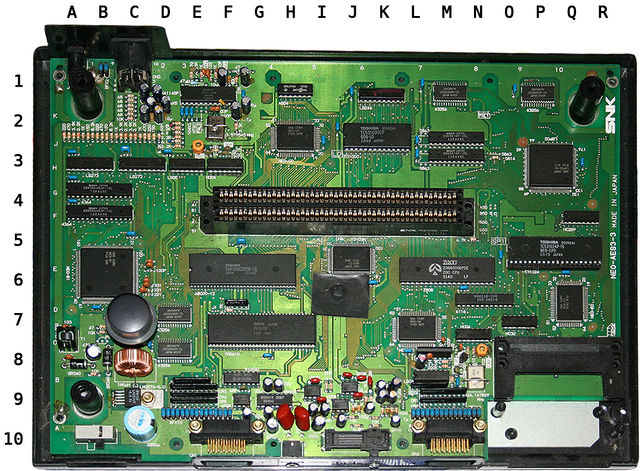NEO-AES3-3 board: Difference between revisions
Jump to navigation
Jump to search
(Created page with "thumb|Picture wanted. Second (?) version of the AES board. =Differences with the NEO-AES board= * Uses the second generation chipset ({{Chip...") |
(added the information about the cases of power not being 9v and advised to have a look at the power page) |
||
| (2 intermediate revisions by one other user not shown) | |||
| Line 1: | Line 1: | ||
Second (?) version of the AES main board. | |||
=Board map= | |||
Original picture by BIG BEAR. | |||
[[File:neo-aes3-3.jpg|640px|center]] | |||
* 1A: [[Power supply]] barrel jack connector | |||
* 1C: Audio/video output [[pinouts|DIN connector]] | |||
* 1EF: [[Video encoder]] | |||
* 1M and 1P: Slow [[VRAM]] chips | |||
* 2ABC: [[Video DAC]] | |||
* 2F: Color burst oscillator | |||
* 2H: {{Chipname|NEO-G0}} | |||
* 2JK: [[L0 ROM]] | |||
* 2MN: Fast [[VRAM]] chips | |||
* 3ABC: Palette RAM latches | |||
* 3PQ: {{Chipname|LSPC2-A2}} | |||
* 4AB: [[Palette RAM]] chips | |||
* 4F~M: Cartridge [[AES_cartridge_pinout|slot]] | |||
* 4Q: System latch | |||
* 5J: {{Chipname|NEO-C1}} | |||
* 5PQR: [[System ROM]] | |||
* 6ABC: {{Chipname|NEO-B1}} | |||
* 6EFGH: [[68k]] CPU | |||
* 6J: Piece of tape protecting the PCB from being scratched by the plastic case | |||
* 6LMN: [[Z80]] CPU | |||
* 7C: [[Reset]] button | |||
* 7D: First [[68k user RAM]] chip | |||
* 7FGH: {{Chipname|YM2610}} soundchip | |||
* 7L: {{Chipname|NEO-D0}} | |||
* 7N: [[Z80 RAM]] | |||
* 7Q: {{Chipname|NEO-E0}} | |||
* 8C: Power supply inductor | |||
* 8D: Second 68k [[68k user RAM]] chip | |||
* 8LMN: Main [[clock]] and [[video PLL]] circuit | |||
* 8OPQR: [[Memory card]] slot | |||
* 9C: [[Power supply]] controller | |||
* 9E: [[Joypad]] input [[CRE401|filters]] | |||
* 9F: {{Chipname|YM3016}} | |||
* 9HIJK: Analog sound circuit | |||
* 9M: More joypad input filters | |||
* 10B: Power switch | |||
* 10F: [[Pinouts#Joypad_ports|P1 connector]] | |||
* 10H: Headphone 3.5mm stereo jack connector | |||
* 10J: Headphone volume slider | |||
* 10M: [[Pinouts#Joypad_ports|P2 connector]] | |||
=Differences with the [[NEO-AES board]]= | =Differences with the [[NEO-AES board]]= | ||
* Uses the second generation chipset ({{Chipname|NEO-B1}}, {{Chipname|NEO-C1}}, {{Chipname|LSPC2-A2}}). | * Uses the second generation chipset ({{Chipname|NEO-B1}}, {{Chipname|NEO-C1}}, {{Chipname|LSPC2-A2}}). | ||
* Analog audio stuff is grouped in one spot. | * Analog audio stuff is grouped in one spot. | ||
* Supposedly power input problem was patched to exclusively work with [[power requirements|9V power supplies]] however there have been cases reported where this didn't happen so make sure to have a look at the [[power requirements]] page for a better understanding. | |||
[[Category:Cartridge systems]] | [[Category:Cartridge systems]] | ||
Latest revision as of 23:50, 25 May 2020
Second (?) version of the AES main board.
Board map
Original picture by BIG BEAR.

- 1A: Power supply barrel jack connector
- 1C: Audio/video output DIN connector
- 1EF: Video encoder
- 1M and 1P: Slow VRAM chips
- 2ABC: Video DAC
- 2F: Color burst oscillator
- 2H: NEO-G0
- 2JK: L0 ROM
- 2MN: Fast VRAM chips
- 3ABC: Palette RAM latches
- 3PQ: LSPC2-A2
- 4AB: Palette RAM chips
- 4F~M: Cartridge slot
- 4Q: System latch
- 5J: NEO-C1
- 5PQR: System ROM
- 6ABC: NEO-B1
- 6EFGH: 68k CPU
- 6J: Piece of tape protecting the PCB from being scratched by the plastic case
- 6LMN: Z80 CPU
- 7C: Reset button
- 7D: First 68k user RAM chip
- 7FGH: YM2610 soundchip
- 7L: NEO-D0
- 7N: Z80 RAM
- 7Q: NEO-E0
- 8C: Power supply inductor
- 8D: Second 68k 68k user RAM chip
- 8LMN: Main clock and video PLL circuit
- 8OPQR: Memory card slot
- 9C: Power supply controller
- 9E: Joypad input filters
- 9F: YM3016
- 9HIJK: Analog sound circuit
- 9M: More joypad input filters
- 10B: Power switch
- 10F: P1 connector
- 10H: Headphone 3.5mm stereo jack connector
- 10J: Headphone volume slider
- 10M: P2 connector
Differences with the NEO-AES board
- Uses the second generation chipset (NEO-B1, NEO-C1, LSPC2-A2).
- Analog audio stuff is grouped in one spot.
- Supposedly power input problem was patched to exclusively work with 9V power supplies however there have been cases reported where this didn't happen so make sure to have a look at the power requirements page for a better understanding.